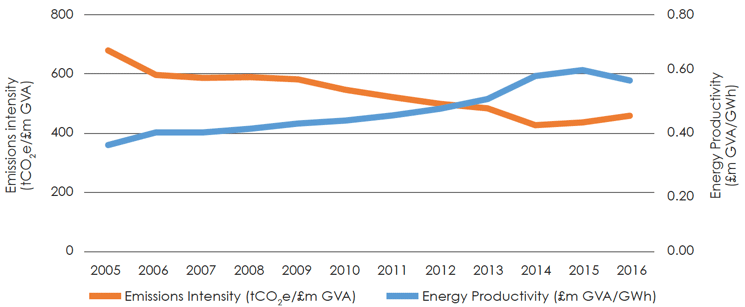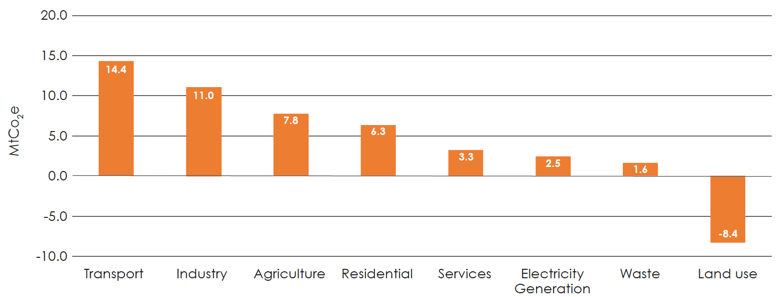Decarbonising Scotland's industrial sectors and sites: discussion paper
This paper outlines our engagement with industry to date.
1. Introduction
1.1. Purpose
Scotland's Energy Strategy[1] committed the Scottish Government to engage with Scottish industry on matters of energy efficiency and decarbonisation. We want to direct public and private sector resources into activities and programmes that will aid the delivery of targets within our Climate Change Plan[2]. To achieve this, we will:
- make the case that decarbonisation can increase economic performance and must be viewed as an investment in manufacturing business;
- outline the profile and trends of Scotland's energy intensive industries (EII), in terms of the sector's economic output, emissions and energy use;
- highlight the barriers to investment in energy efficiency or decarbonisation, gained from engagement with Scottish EII;
- outline the advice and support that is available for industry to invest in energy efficiency or decarbonisation measures, and outline programmes or proposals for Government intervention;
- identify gaps in the provision of incentives, in a Scottish context, with reference to UK and European provisions;
- set out next steps for more focused business support, from Government, that reflects our commitment to manage the transition to decarbonising industry; and
- seek to ensure the regulatory playing field is level for EII competitiveness and protect against carbon leakage through access to emissions trading markets.
This paper summarises our engagement with industry to date, cites the identified barriers to investment in decarbonisation, references the support currently available and proposes next steps to create an improved Scottish support framework.
1.2. Energy productivity and emissions intensity
Our Climate Change Plan (CCP) and Energy Strategy (ES) contain two policy outcomes relevant to EII:
1. By 2032, industrial and commercial energy productivity[3] will improve by at least 30%, from 2015 levels, through a combination of fuel diversification, energy efficiency improvements and heat recovery.
2. By 2032, industrial and commercial emissions intensity[4] will fall by at least 30%, from 2015 levels, through a combination of fuel diversification, energy efficiency improvements and heat recovery.
Analysis shows these targets are consistent with the trajectory outlined in the CCP; to reduce industrial emissions by 21% (or 2.2MtCO2e) over the plan's lifetime (2018-2032).
Figure 1: Comparison of historical (2005-2016) Energy Productivity (GVA/GWh) and Emissions Intensity (tCO2e/£m GVA) in the Scottish Industrial sector

There has been a positive trend of increasing energy productivity and falling emissions intensity since 2005, although from 2014-16 there was a slight reversal. From 2005-16, it is estimated that energy use in the industrial sector fell by a third, and emissions by 28%. Gross Value Added (GVA) in the industrial sector also grew during this time, by around 6% overall. Therefore improvements have resulted from a growing industrial sector with falling emissions and energy usage.
Considering the interaction of energy, emissions and GVA it is clear that in order to make progress, programmes which support investment to reduce emissions whilst developing economic growth are critical to achieve our targets. Reducing industry emissions whilst boosting productivity is challenging. If trends in emissions and energy consumption remain on their current trajectories, due to stalling investment in efficiency or diminishing returns on the gains from decarbonisation, our annually monitored targets are likely to be missed.
Support programmes and incentives currently exist but there remains a significant risk for EII that could lead to carbon leakage (which occurs when domestic industries relocate overseas, where climate or energy regulation may be less stringent). Both support for investment and a regulatory level playing field between the UK and the European Union is needed. That is why the Scottish Government will continue to seek to ensure that we are protected against carbon leakage through access to emissions trading markets after EU Exit – either through continued participation in the EU Emissions Trading System, or through the creation of a UK Emissions Trading System, linked to the EU ETS.
1.3. Industrial decarbonisation as an economic investment opportunity
Industrial decarbonisation is an economic opportunity – to grow our existing energy intensive sectors, and to attract new, advanced manufacturing industries of the future.
The Scottish Government wants to support activity that incentivises investment in existing sectors, building on their considerable existing strengths, some of which are specific to the unique characteristics of industry located in Scotland. We also want to secure investment in new manufacturing sectors attracted by a low carbon energy supply, new fuels such as hydrogen, our R&D excellence, our high skilled labour force, and the locational advantages that clustering and access to carbon capture utilisation and storage (CCUS[5]) infrastructure can offer. Securing technological[6] investment can also help to deliver inclusive growth[7] in Scotland and connect with global Sustainable Development Goals[8].
The case for resources to facilitate investment is more likely to succeed when environmental concerns are allied to supporting economic output and growth at industrial sites. Investment in environmental performance, through transformational change if necessary, can deliver not only cost savings via efficiencies, but also significant reductions in Green House Gases (GHG).
Investment can sustain a significant number of high-value jobs, that are often at the base of supply chains. This economic activity is vital, not only for securing a better future for regional communities, but for the Scottish manufacturing sector and economy as a whole. Our focus is on factors that we can influence, therefore we are working to:
- better target interventions that have an increased chance of industry take-up;
- maximise the effectiveness of public and private sector resources in overcoming barriers;
- prioritise support to where it can best influence outcomes and more directly connect with the delivery of our high level targets; and
- look at the wider economic and social impacts as EII adapt by engaging with initiatives such as Scotland's Just Transition Commission[9].
The high levels of investment that Scottish industry will require to decarbonise must largely be sourced from corporate sources. However, our engagement with industry shows that there are significant barriers to attracting the necessary investment – particularly long payback periods – whilst sites must remain internationally competitive. Consequently, the Scottish Government must assess how we can help make this a more attractive commercial investment proposition, and whether innovative finance (for example 'patient' capital loans and/or equity investment) could be deployed to help stimulate the required investment, where it is possible to provide such capital in the challenging fiscal climate.
1.4. Industrial emissions in context
The most recent GHG emissions statistics show that in 2016, Scotland's Industrial sector was responsible for 11 MtCO2e (around 30% of national (net) CO2e emissions).
Figure 2: Scottish Greenhouse Gas Emissions 2016 (Scottish Government, June 2018)[10]

Investment to decarbonise industry could contribute significantly to overall climate change targets. But there is no room for underperformance in any sector. Increasing visibility should allow industry to secure and deploy resources to meet its share of our demanding decarbonisation targets. Showing the benefits of these emissions savings contextualised in a way that is more tangible, related to everyday activities in other sectors, helps to communicate the potential impact of investment in industry. For example:
- A 1% reduction in industrial emissions (2016) levels would be equivalent to saving the annual emissions of 41,000 cars[11].
- A 1% reduction in industrial emissions (2016) levels would be equivalent to saving the annual emissions from 42,000 households[12].
A 1% reduction in industrial energy consumption (2016) could reduce fuel costs across industry by approximately £20 million per year[13].
Contact
Email: sm.watson@gov.scot
There is a problem
Thanks for your feedback